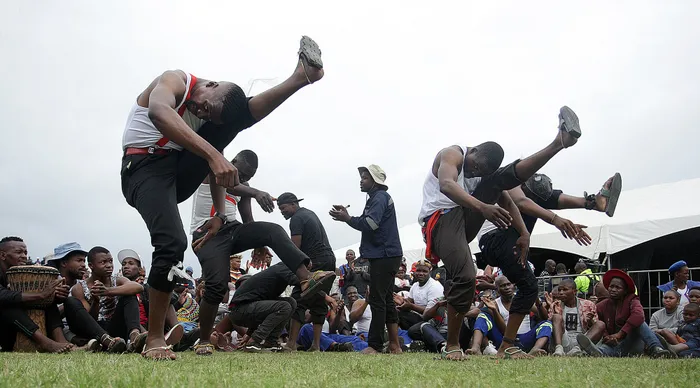Preserving culture, identity central to building the future

Picture: Bongani Mbatha/African News Agency (ANA) - Dancers in a traditional dance ceremony.
By Dr Gugu Mazibuko
This month is celebrated as the Heritage Month in South Africa where we remember our past.
Heritage is often defined as our legacy from the past, what we live with in the present, and what we pass on to future generations to learn from, to marvel at and to enjoy.
There are two types of heritage, that is, tangible as well as intangible heritage.
Tangible heritage means something real, not imaginary. It is something that one can touch or experience. Tangible heritage projects focus mainly on the physical artefacts left by the preceding cultures and civilisation.
In most cases, it is work of architecture and art. Like in some parts of South Africa, some of the tangible heritage is evident in natural geological formation that was adapted by the past people.
A tangible heritage is one that can be stored and physically touched. This includes items produced by the cultural group such as traditional clothing, utensils, bead work, water vessels, traditional weapons, homesteads and even graves.
Tangible heritage includes great monuments such as mountains, buildings, temples, pyramids and public monuments.
Living heritage, or intangible heritage, is another category of heritage status, which is neither monumental nor natural, but represents part of a nation’s identity.
Living heritage represents the intangible aspects of inherited culture. Intangible cultural heritage is described as being transmitted from generation to generation, constantly recreated by communities and groups in response to their environment, their interaction with nature and their historical conditions of existence.
It provides people with a sense of identity and continuity and its safeguarding promotes, sustains and develops cultural diversity and human creativity.
An intangible heritage is that which exists intellectually in the culture. It is not a physical or tangible item. The intangible cultural heritage includes oral tradition and expression, in which it is the domain of oral tradition and expressions in different forms.
For many years, amaZulu gathered their children around the fire at night and tell them stories in which these stories passed language, values, history, religion and legends. And usually the story tellers are old people of the family like a grandparent.
Another intangible heritage example is amahubo which are the nation’s songs that are sung during various ceremonies held by that particular nation.
Furthermore charms, prayers, chants, songs and music are all part of the intangible heritage. Music is one of the things that are found in various cultures whenever they are celebrating something. During happy or sad times people used music to express their feelings.
The occasions in which music or performance art is performed varies. Marriage, funeral, rituals and initiations are functions that mostly require people to sing. However, many performing arts today face multiple threats.
As cultural practices are standardised, the practices of precious arts are abandoned, while at the same time increased popularity may benefit only certain expressions, jeopardising their integrity or irreversibly disrupting the very essence of the tradition.
We need to protect living heritage because it enriches people’s lives, often providing a deep and inspirational sense of connection to community and heritage resources, to the past and to lived experiences. Most importantly living heritage represents knowledge and information sustained through memory and transmitted orally or by practice from one generation to the next.
This means by its nature it is a fragile resource often vulnerable and susceptible to dissipation if not adequately managed in a way consistent with its cultural value, essence and conservation needs.
There is an urgent need to prevent further losses, as heritage is irreplaceable, non-renewable and the need to conserve it for posterity is extremely important.
The question could be asked, why divert money towards preserving the past, when the present contains such immediate needs that require large financial resources? Why preserve monuments and sites that are often redolent of a colonial history when we are trying to construct a post-colonial world?
There are many people who would argue for a fresh start, but an equal number argue that preserving and remembering the past will help us build a stronger future. By protecting heritage sites, we can affirm and celebrate these cultures and their achievements and deepen our understanding of our society. Heritage sites that represent the period of colonialism and apartheid also represent our past and have shaped our identity too. Heritage is part of our identity.
*Dr Gugu Mazibuko is Head of African Languages and Linguistics at the University of KwaZulu-Natal